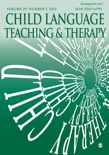
Child Language Teaching & Therapy
Scope & Guideline
Fostering innovation in language intervention for children.
Introduction
Aims and Scopes
- Developmental Language Disorders:
Focus on research and interventions related to children with developmental language disorders, exploring their characteristics, assessment, and effective therapeutic strategies. - Early Language and Literacy Development:
Emphasis on the importance of early intervention in language and literacy skills, particularly during preschool years, to facilitate better educational outcomes and social integration. - Collaborative Practices:
Investigation of collaborative models between speech-language therapists, educators, and families to enhance communication support and intervention effectiveness in various educational settings. - Bilingualism and Multilingualism:
Research on language development and disorders in bilingual and multilingual contexts, addressing the unique challenges and strategies for supporting these children. - Use of Technology in Therapy:
Exploration of innovative tools and technology, such as apps and online interventions, aimed at improving language skills and communication in children. - Parent and Educator Involvement:
Studies focused on the role of parents and educators in promoting language development, including training programs and intervention strategies that engage families.
Trending and Emerging
- Impact of COVID-19 on Language Development:
Recent studies investigate how the pandemic has affected language and communication in young children, particularly regarding parental engagement and support strategies. - Digital and Remote Learning Tools:
An increasing number of publications focus on the effectiveness of digital tools and online interventions for enhancing language skills, reflecting the growing reliance on technology in education. - Play-Based Learning Approaches:
There is a rising interest in play-based methods for teaching language and literacy, emphasizing the importance of interactive and engaging learning environments for young children. - Social-Emotional Learning Integration:
Emerging research highlights the integration of language development with social-emotional learning, suggesting that emotional regulation and communication skills are interconnected. - Culturally Responsive Practices:
A growing trend towards culturally responsive interventions that respect and incorporate children's diverse linguistic and cultural backgrounds is evident in recent publications.
Declining or Waning
- Traditional Speech Therapy Techniques:
There is a noticeable decline in the focus on conventional speech therapy techniques, as the journal increasingly emphasizes collaborative and integrated approaches that involve educators and parents. - Generalized Language Assessments:
The trend has shifted away from broad assessments of language skills towards more specific, context-driven assessments that consider individual children's unique backgrounds and needs. - Focus on Older Age Groups:
Research related to older children and adolescents seems to be diminishing, with a stronger emphasis on early childhood intervention and development in the latest publications. - Singular Language Development Theories:
There is a waning interest in singular theories of language development, as the field moves towards more holistic and integrative frameworks that account for various influencing factors.
Similar Journals
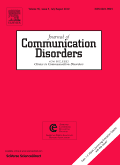
JOURNAL OF COMMUNICATION DISORDERS
Pioneering Insights into Communication Challenges.Journal of Communication Disorders (ISSN: 0021-9924; E-ISSN: 1873-7994) is a leading publication in the field of communication disorders, published by Elsevier Science Inc. With a converged publishing timeline from 1967 to 2024, this journal has established itself as a vital resource for researchers, clinicians, and educators dedicated to advancing knowledge in areas such as linguistics, language processing, speech, and hearing. It boasts an impressive reputation, ranking in the Q1 category for Linguistics and Language, and Q1 in LPN and LVN as well as Q2 in Speech and Hearing for 2023, highlighting its influence and scholarly impact within these domains. The journal is recognized for its rigorous peer-reviewed articles and its contributions to our understanding of cognitive neuroscience, experimental psychology, and communication disorders—further evidenced by its ranking in the top percentiles in various fields. Although it does not currently offer Open Access options, readers and contributors alike will appreciate the depth and breadth of research published within its pages. This journal serves an essential role in bridging the gap between research and practical application, making it a must-read for anyone involved in the study or treatment of communication disorders.

JOURNAL OF PSYCHOLINGUISTIC RESEARCH
Advancing Insights in Psycholinguistic ResearchJOURNAL OF PSYCHOLINGUISTIC RESEARCH is a premier scholarly publication dedicated to the interdisciplinary exploration of language and cognition. Established in 1971 and published by Springer/Plenum Publishers, this journal serves as a vital platform for researchers in Experimental and Cognitive Psychology, Linguistics, and related fields. With an impressive reputation reflected in its 2023 Category Quartiles—Q3 in Experimental and Cognitive Psychology, Q1 in Linguistics and Language, and Q2 in Psychology (miscellaneous)—the journal ranks prominently within the Scopus database, reaching the 88th percentile in Language and Linguistics. Researchers and professionals have the opportunity to disseminate their findings effectively, enriching contemporary understanding of psycholinguistic phenomena through rigorous peer-reviewed articles. Although currently not an open-access journal, it provides extensive access options that cater to a global audience, ensuring that the latest research is readily available to those dedicated to advancing this dynamic field. We invite scholars, practitioners, and students to engage with this essential resource for fresh insights and innovative research methodologies.
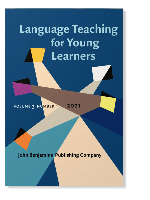
Language Teaching for Young Learners
Advancing research to nurture language skills in children.Language Teaching for Young Learners, published by John Benjamins Publishing Co, is a premier journal dedicated to enhancing the pedagogy of language acquisition in early childhood education. Since its inception in 2019, it has rapidly established itself within the research community, reflected by its high Scopus rankings—placing it in the 85th percentile for Language and Linguistics and the 84th percentile for Education. The journal aims to provide a platform for innovative research, practical insights, and theoretical discussions surrounding the teaching of languages to young learners, thus contributing significantly to the fields of Education and Linguistics. With an open access model currently unavailable, it caters to a diverse global audience, including researchers, educators, and policy-makers, keen on improving pedagogical practices. Located in the Netherlands, the journal's commitment to academic excellence is evident through its Q1 and Q2 rankings in Linguistics and Language and Education respectively, encouraging continual discourse in cultivating effective language education practices.

English Teaching and Learning
Exploring New Horizons in English Teaching MethodologiesEnglish Teaching and Learning is a distinguished academic journal published by SPRINGER SINGAPORE PTE LTD, focusing on the dynamic fields of education and linguistics. With an ISSN of 1023-7267 and an E-ISSN of 2522-8560, this journal serves as a vital platform for researchers, educators, and practitioners interested in advancing the understanding of English language instruction and learning methodologies. Recognized for its high standards, it has achieved a notable Q2 ranking in Education and a prestigious Q1 ranking in Linguistics and Language in 2023, underscoring its impact within these essential scholarly fields. The journal, which spans a converged publication period from 2015 to 2024, endeavors to disseminate innovative research, theoretical insights, and practical applications, making it an invaluable resource for anyone committed to enhancing English education globally. Although it does not operate under an open-access model, its contributions are pivotal in shaping contemporary discourse in English teaching and learning.
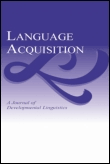
Language Acquisition
Shaping the future of linguistics and educational psychology.Language Acquisition, published by ROUTLEDGE JOURNALS, TAYLOR & FRANCIS LTD, is a leading academic journal dedicated to the interdisciplinary study of language development and acquisition. With an ISSN of 1048-9223 and E-ISSN 1532-7817, this peer-reviewed journal caters to professionals, researchers, and graduate students in the fields of linguistics and educational psychology. The journal boasts an impressive 2023 Scopus ranking of Q1 in Linguistics and Language and Q2 in Education, reflecting its high impact and relevance within academic circles. Notably, it is indexed among the top 15% of journals in Language and Linguistics, showcasing its significance in contributing knowledge to these vibrant fields. Although currently not open access, Language Acquisition makes a profound impact on understanding how individuals acquire language, facilitating discussions on pedagogical strategies, cognitive development, and sociolinguistic factors. The journal's historical and ongoing contributions since its inception in 1990 reinforce its position as a vital resource for advancing research and theory related to language acquisition.
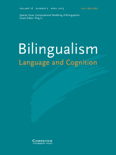
Bilingualism-Language and Cognition
Advancing Insights into Bilingualism and CognitionBilingualism-Language and Cognition, published by Cambridge University Press, is a leading journal in the fields of Education and Linguistics, renowned for its rigorous academic contributions and influential research. With an impressive impact factor placing it in the Q1 quartile of both fields, this journal ranks among the top-tier publications globally, reflecting its commitment to advancing the understanding of bilingualism and its cognitive implications. Since its inception in 2005, Bilingualism-Language and Cognition has garnered significant attention, evidenced by its remarkable Scopus rankings—11th in Language and Linguistics and 12th in Social Sciences. Dedicated to publishing high-quality original research, reviews, and integrative studies, the journal aims to foster interdisciplinary dialogue among researchers, educators, and practitioners. Although not currently an open access journal, it remains a vital resource for those engaged in bilingualism research and its cognitive dimensions, contributing to the academic landscape from its home in Cambridge, United Kingdom.
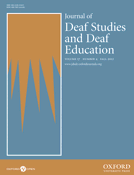
Journal of Deaf Studies and Deaf Education
Advancing understanding in Deaf education and studies.The Journal of Deaf Studies and Deaf Education, published by Oxford University Press, is a leading scholarly resource that focuses on the multifaceted realm of deaf studies, encompassing linguistic, psychological, educational, and social dimensions related to deafness and hearing impairments. With an impactful presence in both the Education (Q2) and Speech and Hearing (Q2) categories, this journal serves as a critical platform for disseminating innovative research and fostering discourse among professionals, educators, and scholars from across the globe. The journal is indexed in high-reputation databases and ranks prominently within the Scopus rankings, indicating its relevance and influence in the fields of Health Professions and Social Sciences. Published quarterly, the journal facilitates comprehensive access to groundbreaking studies and theoretical advancements that aim to improve educational methodologies and outcomes for deaf and hard-of-hearing individuals. As it celebrates two decades of impactful publication from 2004 to 2024, the Journal of Deaf Studies and Deaf Education continues to champion the scholarly pursuits aimed at enhancing understanding and support for the deaf community.
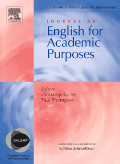
Journal of English for Academic Purposes
Advancing Research in Language and EducationJournal of English for Academic Purposes, published by ELSEVIER, is a premier peer-reviewed journal dedicated to the study and application of the English language within academic contexts. With an impressive impact factor indicative of its significance in the field, this journal is recognized in the Q1 category for both Education and Linguistics and Language, reflecting its high-quality contributions. It ranks 28th among 1088 in Arts and Humanities (Language and Linguistics) and is featured in the top percentile of Social Sciences. As an essential publication for researchers, educators, and language practitioners, it serves as a platform for innovative research that enhances academic English proficiency and teaching methodologies. With its commitment to exploring the intersection of language and education, the Journal of English for Academic Purposes is a vital resource for those aiming to advance their knowledge and practice in English language education. This journal has been actively contributing to the academic discourse since its inception in 2002 and continues to be influential in shaping the future of English language studies and pedagogy.
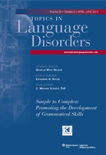
TOPICS IN LANGUAGE DISORDERS
Transforming insights into impactful interventions.TOPICS IN LANGUAGE DISORDERS is a premier academic journal published by LIPPINCOTT WILLIAMS & WILKINS that has been at the forefront of research in linguistics and communication sciences since 1980. Issued in both print (ISSN: 0271-8294) and electronic formats (E-ISSN: 1550-3259), this journal caters to an audience of researchers, clinicians, and students dedicated to understanding and addressing language disorders. With a notable impact factor and categorized in Q1 for Linguistics and Language and Q2 for Speech and Hearing in 2023, it occupies a vital niche in the scholarly discourse around language pathology, presenting rigorously peer-reviewed articles that advance knowledge and practice in the field. Although it is not an open access journal, subscribers benefit from in-depth studies, comprehensive reviews, and case analyses that drive innovation and inform evidence-based interventions. The journal aims to bridge theoretical insights and practical applications, making it an essential resource for professionals seeking to enhance their understanding of communication disorders and develop effective treatment strategies. Positioned in Philadelphia, PA, the journal continues to influence the landscape of language research, maintaining a critical role in nurturing the academic pursuit of excellence in language disorder studies.

Malaysian Journal of ELT Research
Enhancing Instructional Practices with Rigorous ResearchMalaysian Journal of ELT Research is a pioneering platform dedicated to advancing the field of English Language Teaching (ELT) research, published by the Malaysian English Language Teaching Association. With an ISSN of 1511-8002, this journal serves as a vital resource for educators, researchers, and practitioners who are passionate about enhancing English language instruction in Malaysia and beyond. Although specific impact factors are currently not available, the journal's commitment to quality research is evident in its rigorous peer-review process, fostering innovative studies that address contemporary challenges in ELT. The journal embraces a wide range of topics within English language pedagogy, including but not limited to curriculum development, teaching methodologies, and language assessment. It provides an open-access model, ensuring that valuable research insights are readily accessible to a global audience. With its strategic focus on enriching English language education, the Malaysian Journal of ELT Research stands as an important contributor to scholarly discourse in the realm of language teaching and learning.